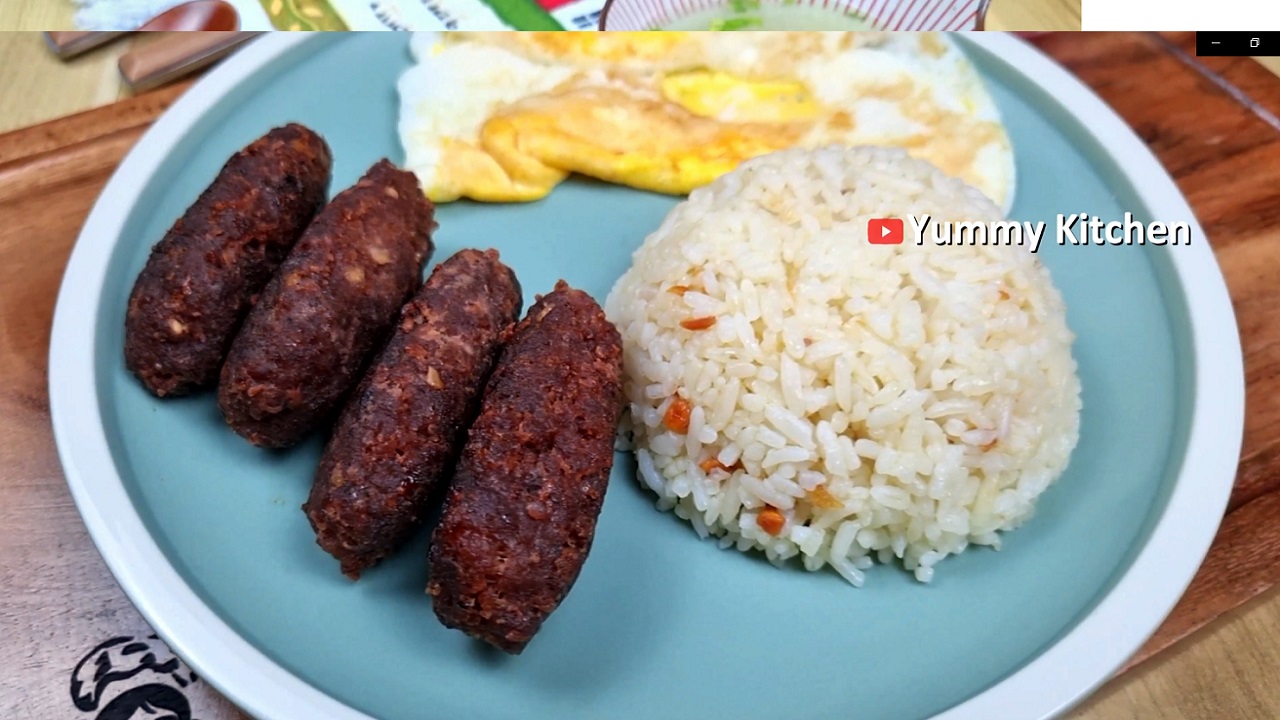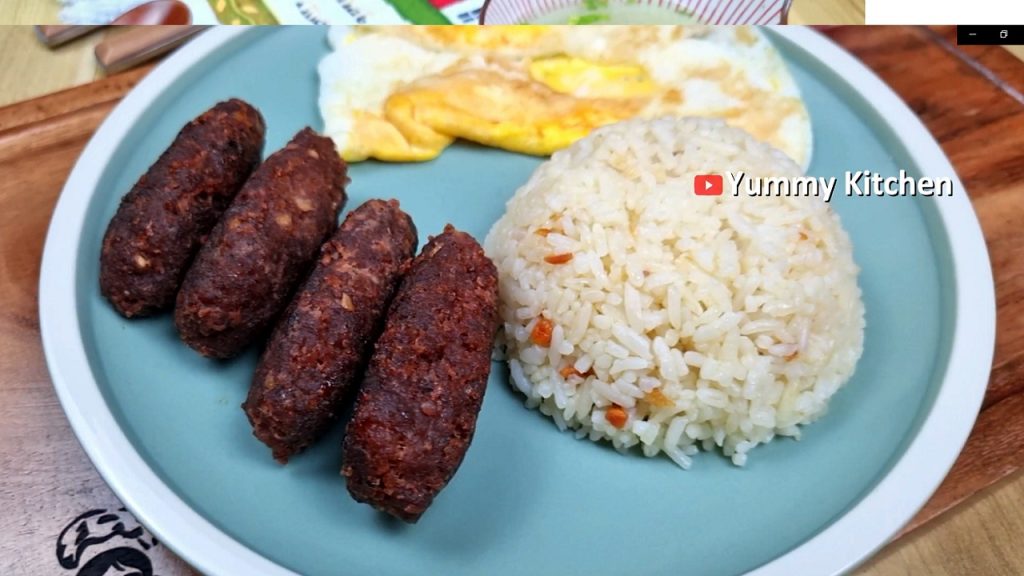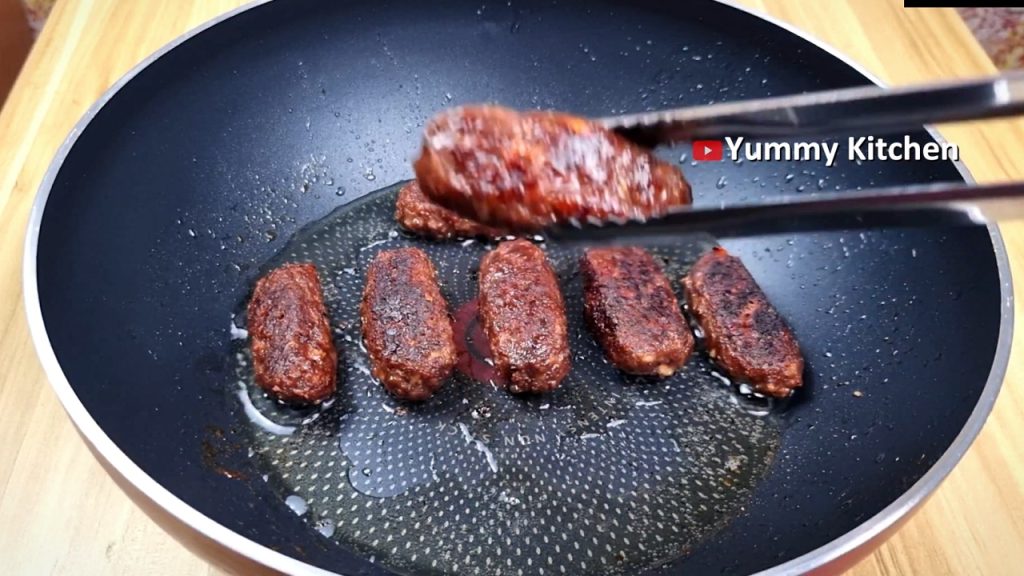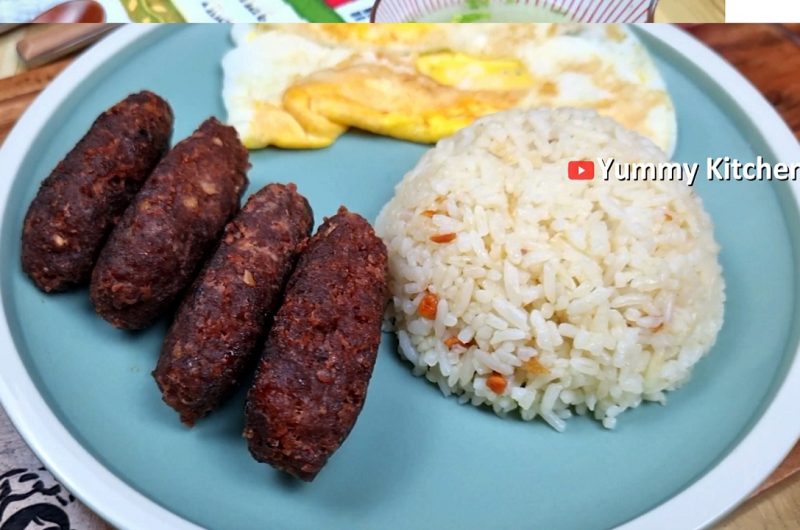Longganisa is a simple Filipino ulam made by frying a meat mixture made with ground pork, garlic, sugar, soy sauce, banana ketchup, pepper, salt and corn starch. This skinless longganisa is not using pork the skin from the pork intestines as a casing to the meat mixture. Compared to the classic version, and is less round and longer in shape. The homemade skinless longganisa is best enjoyed during breakfasts together with egg and fried rice, but can also be consumed anytime of the day.
Homemade Skinless Longganisa Recipe
Ingredients:
- ½ kilo ground pork (fatty option)
- 6 cloves of garlic (minced)
- ¼ cup white sugar
- ¼ cup soy sauce
- ⅓ cup banana ketchup
- ½ teaspoon ground pepper
- ½ teaspoon salt
- 2 tablespoons cornstarch
- 2 tablespoons water
Directions:
- Prepare the ground pork and transfer them into a large bowl. Add the minced garlic, white sugar, soy sauce, banana ketchup, ground pepper, salt, cornstarch and water. Mix until well combined.
- Lay the cling wrap widely on a flat surface. Scoop around 35 – 40 grams of the meat mixture. Roll the cling wrap and mold the meat into a long round shape. Twist to secure both ends. Do the same steps with the rest of the meat mixture.
- You may store the longganisa in a zip lock or container for better storing if you plan to cook it in the next few days or for business. Store the wrapped mixture in the fridge or freeze overnight.
- To defrost, soak the wrapped longganisa in lukewarm water to remove the cling wrap easier.
- Arrange the mixture in the pan. Add a tablespoon of water instead of oil. Cover the pan and let it steam. Use a low heat setting. Flip them from time to time to cook evenly.
- Once the liquid evaporates, drizzle some oil and let them fry using low heat. Flip to cook evenly.
- Once roasted and reddish in color, transfer them to a strainer or paper towel to drain excess oil. Do these steps with the rest of the longganisa.
- Transfer the fried skinless longganisa to your plate and enjoy these with fried egg and garlic fried rice. Yum!
The Not-so-long History of Skinless Longganisa
The term longganisa came from the word “longaniza” from Spain. This dish is used interchangeably with the Spanish chorizo. The main difference between the two is that the chorizo is a type of sausage which is cured and smoked and can be eaten readily, while the longaniza must be cooked first before eaten. Since the Philippines was colonized by the Spaniards for a long time, we adapted their way of creating sausages, and eventually added our own touch to the dish.
Longganisa is a common meat product you can see at the market. The main characteristic which defines this dish instantly is that they are the round red sausages which are twisted one after the other. Savory meat mixture is encased in the skin of the pork’s intestines. The two main flavors of the longganisa are the adobo (garlic flavor) and hamonado (sweet).
Advantage of Homemade Version
Longganisa is one of the best breakfast ulams ever created. If you enter any silogan, longsilog (longganisa, sinangag, itlog) will always be on their best selling items. Longsilog has been my favorite breakfast for quite a long time. There were times where I had longganisa both for breakfast and baon for school.
Based on my personal experiences, my love for longganisa shifted from wanting the hamonado variant when I was a child to the adobo variant when I became an adult. Maybe it’s because of the sweetness. If you want to start introducing this to your kids, you can start with the hamonado one.
Longganisa can be a good business idea if you want a product which will sureball hit the market. Either sell them as frozen packs of ready to cook ones, or have a mini karinderya and have them ready to eat. A piece of longganisa can now be sold at 10-15 pesos each. With just small puhunan, longganisa can fill both your tummy and your piggy banks!
If you want to know a quick recipe to start your longganisa business, go read and follow the simple steps below. Happy cooking!
How to Make Skinless Longganisa
Homemade skinless longganisa is one of the best products if you want to start a small business. Aside from the profit, you can also enjoy one of the classic silog ulams for your daily breakfast!
Every longganisa starts with ground meat. It is your choice if you want to create a chicken and beef variant, but pork longganisa isa one of the easiest and yummiest. To create a best selling pork longganisa, grab the fatty option of the giniling instead of the regular one. In this way, it will feel juicier when cooked.
Once the ground pork is ready, I like to season them according to my taste. I am a fan of super garlicky longganisa, so in this recipe, I used around 6 cloves of garlic (that’s almost a whole one!) You can experiment with the seasonings to be added in the meat but I have listed some of the basic ones in the ingredients list below. Always do a taste test after adding seasoning. (Remember that you’re dealing with a large batch!) To do this, fry a little portion of the meat mixture and adjust the taste afterwards.
When the meat mixture is done, time to wrap them up! Since this version of longganisa is skinless, we do not need the pork intestine. To keep the shape, we are going to use cling wrap or any plastic wrap. Quick disclaimer, wrapping the longganisa is easy, but if you are dealing with a large batch, it might take you a long time and it’s better to have a companion to help you.
Lay the cling wrap widely on a large surface. You can also pre-cut them. How large your cling wrap is will depend on the size of the longganisa you are making, whether they are the regular-sized ones or the jumbo ones. Just like what we do in a lumpia, scoop a portion of the longganisa mixture and wrap and roll using the cling wrap. Using this technique, you can also try making a pork longganisa patty by making the shape flat and round instead of long and round.
After wrapping all the mixture, do not cook them right away as they are not compressed enough. More likely, they will crumble and scatter in the pan. To make them firm, freeze them first. For personal consumption, you can store them in a container and cook them whenever you like. For pang-benta, you can start portioning them into their specific packages.
Once you get them out from the freezer, they are super cold and hard. Make sure to defrost them first by dipping into lukewarm water. Do not cook them right away. If you do that, the outside will be fully cooked and crusted, but the inside will remain cold.
Once thawed, arrange them in a pan and add some water. (Don’t forget to remove the cling wrap!) Let them steam first. Covering the pan will also trap the heat, causing the natural fats from the pork to soften and render. I drizzled a small amount of oil after steaming, but if your longganisa is fatty enough, just let them cook in its oil.
The longganisa is now ready to be served. Prepare your garlic fried rice using the excess oil from the savory longganisa. Have the sunny side up egg and the condiments ready and let’s enjoy the breakfast together. Yum!
Homemade Skinless Longganisa
Course: Pork Recipes5
servingsIngredients
½ kilo ground pork (fatty option)
6 cloves of garlic (minced)
¼ cup white sugar
¼ cup soy sauce
⅓ cup banana ketchup
½ teaspoon ground pepper
½ teaspoon salt
2 tablespoons cornstarch
2 tablespoons water
Directions
- Prepare the ground pork and transfer them into a large bowl. Add the minced garlic, white sugar, soy sauce, banana ketchup, ground pepper, salt, cornstarch and water. Mix until well combined.
- Lay the cling wrap widely on a flat surface. Scoop around 35 – 40 grams of the meat mixture. Roll the cling wrap and mold the meat into a long round shape. Twist to secure both ends. Do the same steps with the rest of the meat mixture.
- You may store the longganisa in a zip lock or container for better storing if you plan to cook it in the next few days or for business. Store the longganisa in the fridge or freeze overnight.
- To defrost, soak the wrapped longganisa in lukewarm water to remove the cling wrap easier.
- Arrange the longganisa in the pan. Add a tablespoon of water instead of oil. Cover the pan and let it steam. Use a low heat setting. Flip them from time to time to cook evenly.
- Once the liquid evaporates, drizzle some oil and let them fry using low heat. Flip to cook evenly.
- Once roasted and reddish in color, transfer them to a strainer or paper towel to drain excess oil. Do these steps with the rest of the longganisa.
- Transfer the fried skinless longganisa to your plate and enjoy these with fried egg and garlic fried rice. Yum!






